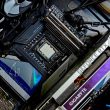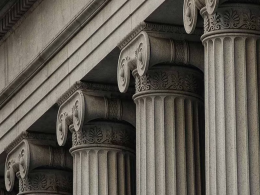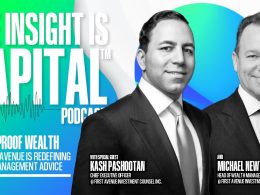by Hubert Marleau, Market Economist, Palos Management
Last week, I wrote: “Contrary to Goldman Sachs, which gave a 45% chance of a recession in the next 12 months, while JPMorgan and Polymarket.com were even more bearish, at 65% and 60% respectively, I reduced my own subjective odds of a recession from 50% to 35%. Recessions usually do not happen when the yield curve is not inverted (10s minus 2s is 50 bps); when the energy bill as a % of N-GDP is as low as it is presently (2.1%); when the increase is the money supply is accelerating (3.7% to 5.8%); when the swap market is predicting a forthcoming reduction in the policy rate of about 60 bps; and when the dollar becomes competitive, the DXY being down 5.0% y/y. All of that is particularly promising as there is more optimism around China, stabilization in earnings revisions, and few headcount reductions in corporate America. Incidentally, despite high recession expectations, the Atlanta Fed’s GDPNow model estimate for real GDP in Q2 is 2.2%, while the other NowCast model sees Q2 GDP at +1.4% and Q3 at 1.3%. Both models signal a slowdown, not a contraction.”
What Is the Optimal Tariff Rate for the US?
The trade rules are still being rewritten and the ink is not dry. Indeed, a plethora of moving parts, shifting variables and dizzy tariff twists, leading to assumptions on which prospects for growth and inflation depend, could be completely changed on a dime without warning. Yet, as investors, we must think of something to decide what to do in the market. Here is my take: the analysis is far from perfect, but it rationalises that the downside risk is more linear than before, and therefore easier for strategists to conjecture.
The US Council of Economic Advisers said that there is an optimal tariff rate for the US that maximises tax revenues while benefiting the economy, which is higher than the 2% or 3% that seems in place now. In a paper published by them, called A User’s Guide to Restructuring the Global Trading System, it cited research that the optimal tariff is around 20% - 60% on China and 10% on the rest of the world. The talk on the street is that the US initiative will bring about across-the-board tariffs of 10% on countries with basically balanced trade accounts and/or friendly relations, and 30% - 60% for countries with which the U.S. has huge trade deficits or un-amicable relationships. As more and more trade accords are signed, however, an equilibrium will likely be reached through a moderate regime, thereby lowering recession risks even more.
The Federal Reserve Bank of Atlanta has just raised its estimate for GDP growth in Q2 to 2.5%, while Goldman Sachs reduced its recession odds to 35% from a prior estimate of 45%, and the Yale Budget Lab’s analysis, incorporating the latest China and UK trade deals, reveals that US households are now facing an effective tariff rate of 17.8%, enough to push inflation up by 1.7%, reduce GDP growth by 0.7% and increase the unemployment rate by 0.4%. Bloomberg’s Neil Dutta is a bit more optimistic, pegging the effective tariff rate at 13.5%. Both cases are tantamount to a slowdown, but not a recession. Interestingly, the swap market is presently predicting that consumer inflation will be 2.8% in a year’s time, compared to 4.1% three months ago, in spite of a 25 bps increase in 10-year Treasury yields to 4.50%. Put simply, all this is painting a picture that economic activity is gradually and slowly diminishing rather than one where the economy is being buffeted by collapsing demand and runaway inflation.
So What Went On Last Week, Ended May 16?
Over the weekend, there was only one important sensitive economic story: The U.S. and China trade officials met in Geneva for high-level talks. With distrust running high and deep, there weren't any expectations of a big breakthrough, or that a comprehensive trade deal would be signed. However, there was hope that their discussions might deescalate tensions, aim for lower tariffs, and produce a framework for a new trade agreement. In this connection, U.S. Trade Representative Jamieson Greer, said it was a “very constructive two days”, indicating that the differences were not as large as might have been thought. Scott Bessent cited “a great deal of productivity” in resolving discrepancies, and President Trump himself wrote on social media in bold letters: “GREAT PROGRESS (was) MADE!!!”. A press release from the White House announced that the US had a deal with China to reduce the trade deficit, while the Chinese delegation described the weekend meetings as “candid, in-depth and constructive dialogue”. Shortly after, the S&P 500 jumped 1.1%.
On Monday, the U.S. and China agreed to slash punishingly high tariffs on each other’s goods (the US from 145% to 30% and China from 125% to 10%) for a 90-day truce while they find a more permanent solution. It looks like another win again for the US as inflationary expectations in one year’s time fell dramatically from 3.3% to 2.8% and a 1930 scenario was thereby avoided. All markets, including the forex and bond markets, roared their approval, the S&P 500 surging 3.1% to 5836, above its 200-day moving average and only 4.5% from the all-time high of 6144.
While this is a good starting point, it is still an indirect warning of what could happen if a permanent deal isn't reached. Put simply, de-escalation does not mean that everything is all clear, because as Washington raises barriers, they are declining elsewhere. The US will surely shift criticism toward the E.U. Indeed, on Tuesday, investors were reminded that the pause was temporary. Andrew Lees of MacroStrategy explained the underlying schisms, including the trade deficit and the underlying fentanyl issue, that had led to the dispute in the first place, was still about. Chicago Fed President Austen Goolsbee agreed that the pause was definitely less impactful than the path the U.S. and China has been on. “Still, the temporary tariff rate is definitely 3 to 5 times higher than what it was before, so it's going to have a stagflationary impulse on the economy”. Indeed, even though the tariffs have started to creep in, the BLS reported that the expected inflation pick-up did not materialise in April, the headline CPI having risen only 0.2%, generating a y/y increase of 2.3%, the smallest since 2021. Over the three months, inflation had ran at an annual rate of 1.2%. This was excellent news, the S&P 500 rising again to 5887, registering an increase of 0.7%.
On Wednesday, the stock market hardly budged, but wiped out 2025 losses, rising 0.1% to 5893, despite a huge across-the-board increase in bond yields - an epic recovery as Trump pivoted to being a global salesman from a tariff man, selling planes for Boeing, chips for Nvidia, partnerships for Amazon, AMD, and others.
On Thursday, although retail goliath Walmart and the all-mighty Fed flashed yellow warnings that higher prices on tariff-affected merchandise were coming up, and more price volatility from supply shocks were due, the S&P 500 still scored a 4-day winning streak without help from the technology sector, rising 0.4% to 5917. This can only be attributed to favourable inflation data, positive employment numbers, retail sales and factory output holding up - plus, of course, solid corporate earnings. Even wholesale prices were down 0.5% m/m, slowing dramatically to 2.4% y/y in April from 3.4% in March. Meanwhile The Atlanta Fed’s GDPNow tracking model showed real consumer spending rising 3.7% (saar).
As an aside, Reuters reported that bookings for container shipments from China to the U.S. spiked 300% in the wake of the 3-month pause.
On Friday, the University of Michigan’s popular gauge of consumer sentiment edged down to 50.8 as views of current conditions fell and inflation expectations spiked. Peak tariff may have passed, but the fact remains that uncertainty over U.S. trade policy continues to dominate the outlook. The S&P 500 picked up steam in the latter hours of the session, climbing 0.5% to 5958, and notching a 5-day win streak with 434 companies of the 500 closing higher: quite remarkable.
The Near-Term Stock Market Outlook
The bulls definitely have the upper hand at this point: the US stock market is clearly not pricing in a recession, and shows that businesses have been able to cope with intense headwinds, which is why I altered my own view on the trading range for the S&P 500 to 5500 and 6000, three weeks ago from a previous forecast of 5300 and 5600; and if I'm right on this one, the rally is due for a pause. Thus I think that the best thing investors can do right now is to sit tight and hold their ground because odds of a recession might be lower, but still are elevated, perhaps lightly adding to their preferred positions during dips to lower their cost averages.
A dear friend emailed a wise quote from Michael Cembalest, who heads JPM’s market and investment strategy: “History and dispassionate analysis tend to be good guides for investing.” He explained; “The stock market is unique. It cannot be indicted, arrested or deported; it cannot be intimidated, threatened or bullied; it has no gender, ethnicity or religion; it cannot be fired, furloughed or defunded; it cannot be primaried before the next midterm election; and it cannot be seized, nationalised or invaded. It is the ultimate voting machine, reflecting prospects for earnings growth, stability, liquidity, taxation, inflation and predictable rule of law.”
My friend cleverly commented with the following line: “Unique it may be, but under Trumpworld’s rule of law, ‘predictable’ it is not.”
Copyright © Palos Management














